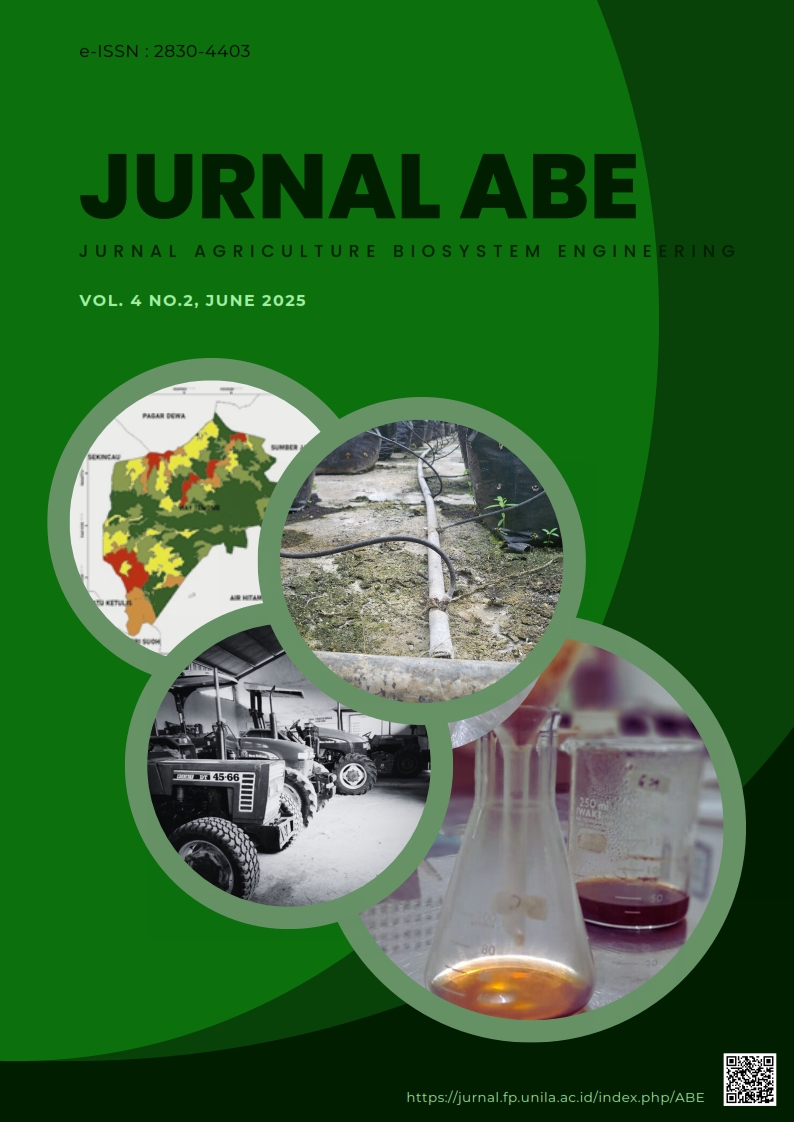Monitoring VPD (Vapor Pressure Deficit) pada Greenhouse dengan Ventilasi Alamiah
DOI:
https://doi.org/10.23960/jabe.v4i3.11606 Abstract View: 136
Abstract View: 136
Keywords:
Vapor Pressure Deficit (VPD), Greenhouse, Natural Ventilation, Precision agricultureAbstract
Greenhouses with natural ventilation face challenges in maintaining a stable microclimate, particularly in managing air temperature and humidity, which affect the Vapor Pressure Deficit (VPD). This study aimed to monitor and analyze VPD levels inside a naturally ventilated greenhouse using misting (fogging) treatments at different heights, in order to determine the most effective strategy for VPD control. The research was conducted at the Department of Agricultural Engineering, University of Lampung, using three treatments: no fogging (T1F0), fogging at 50 cm (T2F50), and fogging at 100 cm (T3F100) above the plant canopy. Temperature and humidity data were collected using DHT22 sensors and a hygrometer, and used to calculate VPD values. The results showed that the 50 cm fogging treatment (T2F50) effectively reduced VPD to an average of 0.97 kPa, which is within the optimal range (0.5–1.2 kPa) for plant growth. In contrast, the no-fogging treatment produced the highest VPD value (2.17 kPa), which could cause plant stress. Statistical analysis (ANOVA and LSD test) indicated that fogging height significantly influenced VPD values, especially under hot weather conditions. Therefore, fogging at 50 cm is recommended as the most effective treatment for maintaining optimal VPD in naturally ventilated greenhouses.
Downloads
References
Bakker, J.C. Analysis of Humidity Effects on Growth and Production of Glasshouse Fruit Vegetables. Ph.D. Dissertation, Agricultural University,Wageningen, The Netherlands, 1991; p. 155.
Iwaniak, A, Janczukowicz, W, J. Tren baru dalam Teknik lingkungan, pertanian, produksi pangan, dan analisis. Aplikasi sains. 2012, 11, 2745.
Massinai, M. A., Hasanah, N., & Prodi, N. (2011). Analisis Perubahan Suhu Udara Permukaan Kota Makassar , 2-3. Melo, O. E. (2012). Komputerisasi Smart Greenhouse untuk Budidaya Tanaman Bunga Krisan , 18.
Nuryanto, D.E. 2012. Keterkaitan Antara Monsun Indo-Australia Dengan Variabilitas Musim Curah Hujan di Benua Maritim Indonesia Secara Spasial Berbasis Hasil Analisis Data Satelit TRMM. Jurnal Meteorologi dan Geofisika, 13(2):91-102.
Siswanti, K.Y. 2011. Model Fungsi Transfer Multivariat dan Aplikasinya untuk Meramalkan Curah Hujan Di Kota Yogyakarta. Skripsi. Yogyakarta : FMIPA Universitas Negeri Yogyakarta.
Widyarti, M. Suhardiyanto, H. & Muliawati, I, S. (2004). Analisis laju ventilasi alam pada single span greenhouse, Cikabayan, Kampus IPB Darmaga, Jurnal Keteknikan Pertanian, 18 (1).
Zhang, D.; Du, Q.; Zhang, Z.; Jiao, X.; Song, X.; Li, J. Vapour pressure deficit control in relation to water transport and water productivity in greenhouse tomato production during summer. Sci. Rep. 2017, 7, 43461.
Downloads
Published
How to Cite
Issue
Section
License
Copyright (c) 2025 Muhammad Ivanka Apriyatama, Ahmad Tusi, Winda Rahmawati, Diding Suhandy

This work is licensed under a Creative Commons Attribution-NonCommercial-ShareAlike 4.0 International License.
Authors who publish with this journal agree to the following terms:
Authors retain copyright and grant the journal right of first publication with the work simultaneously licensed under a Creative Commons Attribution-ShareAlike 4.0 International Lice that allows others to share the work with an acknowledgement of the work's authorship and initial publication in this journal.
Authors are able to enter into separate, additional contractual arrangements for the non-exclusive distribution of the journal's published version of the work (e.g., post it to an institutional repository or publish it in a book), with an acknowledgement of its initial publication in this journal.
Authors are permitted and encouraged to post their work online (e.g., in institutional repositories or on their website) prior to and during the submission process, as it can lead to productive exchanges, as well as earlier and greater citation of published work (See The Effect of Open Access).
Jurnal Agricultural Biosystem Engineering

JABE is licensed under a Creative Commons Attribution-ShareAlike 4.0 International License.




